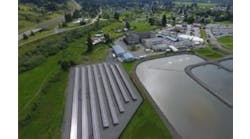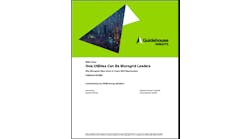How can energy customers get the full value from their microgrids and distributed energy resources? One approach is asset-backed demand response, explained in this final excerpt from a new special report by Microgrid Knowledge and NRG Energy
Download the full report.
A push-and-pull between government energy policy and technological evolution helped promote today’s microgrid markets. Those who understand the changes — and how to maximize opportunities — stand to gain the most from local energy.
Government pushed technological innovation via incentives and a gradual opening of wholesale markets. This led to greater production, economies of scale and falling prices. And that in turn led to even wider distributed energy penetration.
Now technology is pulling government, as software capabilities, electronic controls and energy storage advance faster than regulation. Federal and state regulatory agencies are scrambling to understand and react to the trends, exploring questions about the value of distributed energy resources, how to give them a fair position in markets and what role, if any, utilities should play.
At the same time government is creating new mandates for renewable energy, requirements that add cleaner but also less consistent energy resources to the grid. Solar and wind energy ebb when the sun is not shining, or wind is not blowing. So other sources of energy must balance supply and demand. Microgrids receive monetary compensation for providing this service.
Energy companies with extensive market experience understand not only where these changes are leading but how to maximize them now for customers. For microgrid technology, in particular, the opportunities are substantial, as microgrid operators increasingly use the technology for energy arbitrage and sale of services into a competitive wholesale market.
That changes the business equation for the microgrid industry. When a microgrid is used as more than backup power—and instead becomes a means to cut costs and generate income—payback can be quicker.
Still, due to wholesale market complexity, even a flexible microgrid may face barriers to full use of its assets. Each of the RTOs and ISOs in North America have rules and regulations that require a level of sophistication from participants. A business that does not specialize in energy is likely to become overwhelmed if it tries to navigate these markets on its own.
Fortunately, the industry is now adopting financial models pioneered by the energy efficiency and solar industries when they faced similar problems.
Expert management and no upfront costs
Both the energy efficiency and solar industries grew by offering contracts that spared customers from paying upfront equipment costs and assuming operational risk. Instead, they employed a third-party ownership model.
For microgrids, this means a third party owns and operates the equipment, ensuring it serves the customer properly. The customer pays only for the energy and related services. Revenue or savings from the microgrid can help offset customer costs.
The emergence of asset-backed demand response
Out of these approaches, a new and sophisticated model has evolved, what NRG calls asset-backed demand response. A third-party ownership structure, asset-backed demand response is initially being built around use of onsite natural gas generators, with the intent of adding additional resources over time, such as energy storage and solar.
NRG deploys and manages all aspects of the microgrid: design, construction, installation, ownership and operation. If the customer already has generators on-site, NRG can take ownership. The customer pays no upfront costs for the microgrid system; instead the asset is backed by NRG.
Ideally, market revenues mean the customer pays no fee and benefits from a lower and more stable energy spend. Any form of customer fee only makes sense if the customer was going to buy the generators anyway.
So with the asset-backed demand response solution, the customer receives highly reliable energy without making a capital outlay. The customer pays only a fee for service, which NRG works to offset via demand response, market arbitrage and other revenue streams, using its deep expertise in wholesale power markets and electricity pricing. One of the largest independent power production companies in the U.S., NRG owns and operates 30,000 MW of generation assets, and trades regularly in wholesale energy, capacity and markets. The company also serves 3 million business and residential customers on the retail level.
After years of technological, regulatory and market advancements, microgrids have arrived as a natural outgrowth of the quest for reliable and localized power.
The asset-backed demand response model moves beyond just microgrid operations. NRG focuses on the customer’s entire energy spend, looking for opportunities to generate revenue or achieve price stability.
For example, the approach achieves cost stability for a customer not only through demand response, but also by finding ways to modify the timing and amount of grid power the customer uses, what’s known as load shaping. NRG operates the microgrid generators to configure usage into a pattern attractive to wholesale power suppliers. This positions the customer to capture better supply pricing. As part of the asset-backed demand response (ABDR) package, NRG also procures supply for the customer, structuring contracts based on price and the customer’s risk tolerance. In doing so, NRG acts as a complete energy management provider — not just as the microgrid owner and operator.
“ABDR draws a range of benefits from a microgrid. Clearly, this isn’t something a customer with a microgrid can do independently. Gaining these benefits requires a partner experienced in power markets and asset operation who can apply knowledge and take on risk for the customer. This is what NRG offers,” said Robert Hanvey, vice president, strategy and business development at NRG. He added, “With this approach to microgrids, your energy system becomes more than an insurance policy; it’s a financial tool.”
As sophisticated as ABDR may sound, it’s only the beginning. According to Hanvey, the next phase of the DER evolution has begun with the cutting-edge virtual power plant (VPP), microgrid cluster and a distributed asset control system (DACS).
Next: The VPP, microgrid cluster and DACS
What if your DER could act in concert with DERs operated by others? Could economies of scale or other advantages be achieved? The short answer is yes. This is where the VPP, microgrid cluster and DACS come into play.
Advanced software intelligence can coordinate the operations of multiple DERs and sometimes multiple microgrids, even those with multiple system owners. Working together, DERs and microgrids can achieve better efficiencies and leverage market opportunities not necessarily available to them if they act alone.
A VPP aggregates multiple DERs and orchestrates their operation via a central control system. It is a collection of intelligently controlled DERs—ranging from microgrids to home energy management devices—that together serve the grid the same way a power plant would. Consider a scenario where the grid needs one megawatt because it is under strain: Several natural gas generators, linked together contractually but sited at separate businesses, might simultaneously activate by a master controller to generate one megawatt for their hosts. This would remove one megawatt of demand on the grid—which has the same effect as adding one megawatt from a power plant. Hence, the aggregation of generators “virtually” produces power and receives financial compensation for providing the grid service.
A microgrid cluster is a similar concept. Via sophisticated controllers, multiple microgrids communicate and exchange services to improve efficiency or price or achieve other predetermined goals. Today, microgrid clusters are being tested for neighborhoods, universities and businesses. Some futurists envision microgrid clusters becoming the primary source of U.S. electricity with the main grid acting as a backup.
Where the DER evolution brings us today
After years of technological, regulatory and market advancements, microgrids have arrived as a natural outgrowth of the quest for reliable and localized power.
These mini-power plants not only supply backup power, but also serve as a financial asset. In addition, local energy gives consumers a new, empowered status. They are no longer just buyers; they can be producers and market players as well.
Such sophistication not only brings greater market benefits; but also demands a deeper understanding of energy markets and technology.
None of this is simple, of course, but that’s where an expert energy partner comes into play, one with a deep understanding of energy technology and markets. For the savvy organization that forms such a partnership, new opportunity awaits.
Read the report’s other four chapters:
- What the Rise of Local Energy Means for Businesses, Institutions and Communities
- DER Technology Comes of Age: Smart and Sophisticated
- The Market Evolution of Distributed Energy: New Ways to Value Solar Power and Other DERs
- The Rise of Microgrids and DERs: Out of Competition Came Innovation
For more on the rise of local energy, see the full special report, “The Evolution of Distributed Energy Resources What the Rise of Local Energy Means for Businesses, Institutions and Communities,” courtesy of NRG, downloadable free of charge.







